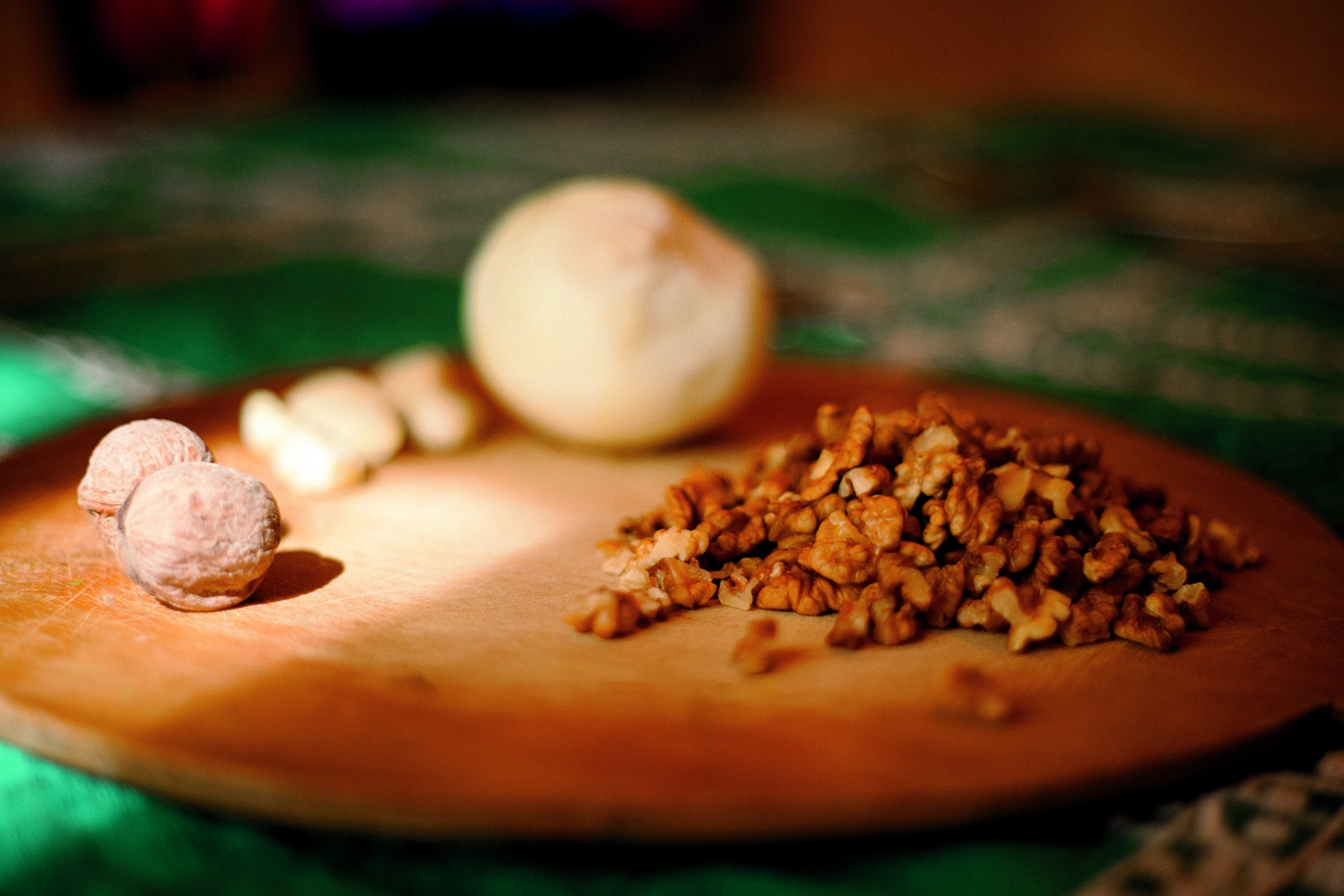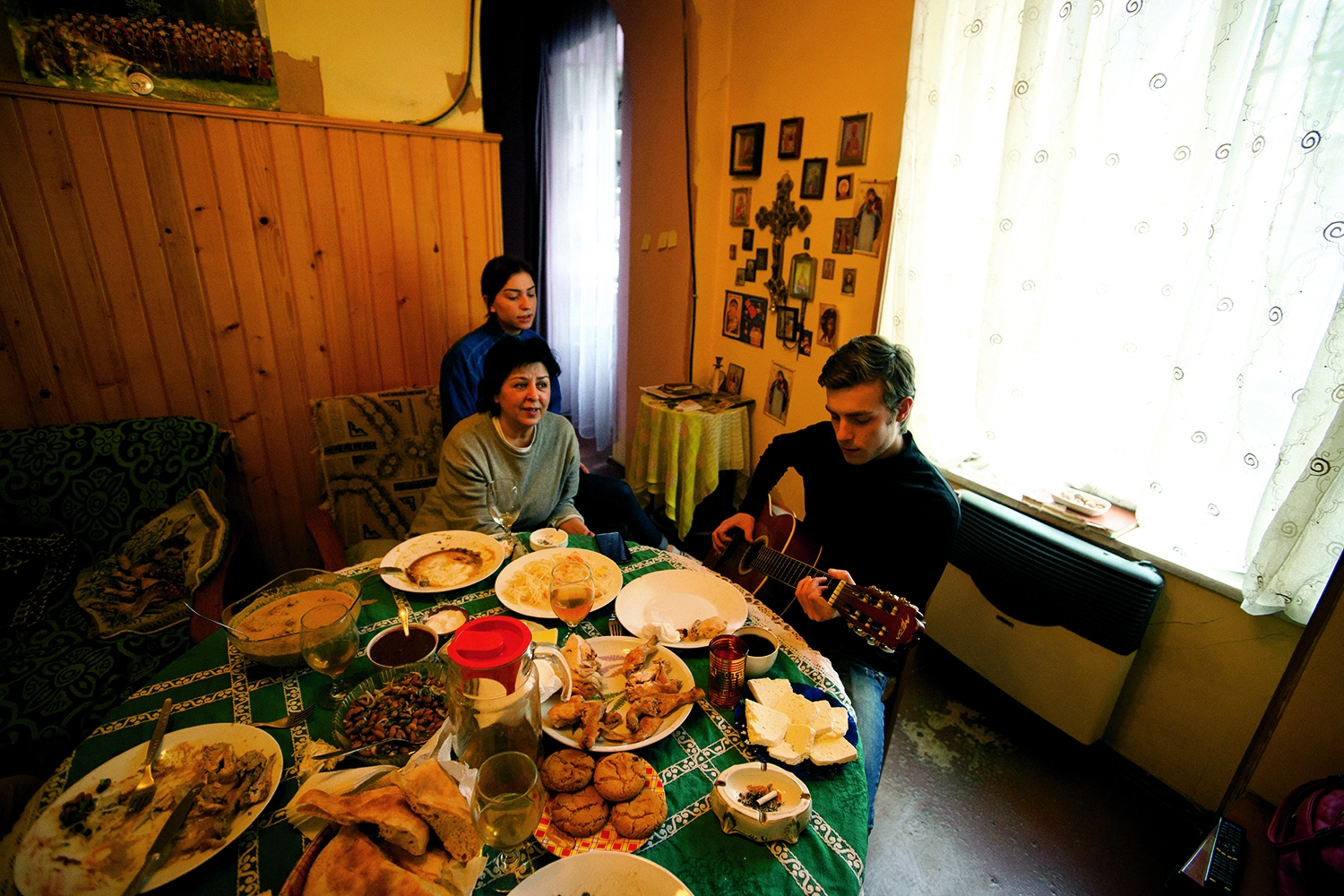Our feast ends just as the singing begins. A mother and daughter, eyes closed, harmonize, two voices rising to a mournful peak as the young son and brother plucks an acoustic guitar and sings a soft baritone.
Such impromptu performances are common in the nation of Georgia, where the polyphonic musical tradition is a cultural touchstone. But this one came as a surprise. I’d come to this rundown part of the atmospheric capital, Tbilisi, to learn another tradition, a specialty called satsivi. I didn’t realize they would go hand in hand.
Georgian cuisine is marked by an explosion of flavors that is heavy on produce, spices and herbs, a sweet-tart balance even in savory dishes. It’s said the land is so fertile, you could stick a pencil in the ground and it will grow into a tree.
Satsivi—an herb-laced stew of shredded chicken coated in a thick puree of walnuts and onions—resembles a pale Indian curry, but only in appearance. It is powerfully garlicky and scented with saffron and coriander, and gets a kick from paprika. Though they’re native to the region, walnuts are expensive in the former Soviet republic, which means satsivi is normally reserved for festive occasions, especially New Year’s Eve.
Maia Monaselidze—a former café owner and the housekeeper at my hostel in Tbilisi’s historic center—invited me to her home to show me how to make the dish. When I arrive at the two-room apartment, women are outside hanging laundry on lines that run across the central courtyard. Cracks mar the walls of the 19th-century building, where 27 families live piled atop each other.
Inside, her college-age children are still sleeping off late-night shifts at restaurants. An inherited collection of vintage wooden clocks adorns one wall, a crucifix surrounded by a shrine to Christian Orthodox saints marks another.
Monaselidze starts on the chicken: spatchcocked, then simmered whole in water. Some of the resulting broth is reserved for the walnut sauce. She moves the chicken to a roasting pan, weighing down the breast with a worn wooden block, and roasts it at high heat until a flavorful brown skin develops.
She sautés an onion with garlic and heaping spoonfuls of saffron, coriander and paprika. Traditionally, the spice mix and walnuts are mashed together with a mortar and pestle, but Monaselidze prefers the convenience of a blender. She returns her attention to the chicken, pulling it apart, then putting the shreds into the finished sauce. More saffron and salt are added for good measure.
The table fills. Garlicky beans flecked with fresh parsley and cilantro; tangy shredded cabbage and carrots; a plate of imeruli, a young, brined curd cheese. A second roast chicken is meant to be eaten with tkemali, a savory sour-plum jam made once a year that also includes a few ground tablets of aspirin as a preservative.
The satsivi is usually eaten cold (“tsivi” means “cold” in Georgian), but we don’t want to wait, so we start scooping it up with hunks of bread. It’s peppery and creamy, with a hint of cilantro and some mild spice from the paprika. Everything is washed down with a mineraly, amber-colored wine that tastes of the clay pots that have been used to age wine in the Caucasus Mountains for 8,000 years.
The children wake up just as we’re finishing, and Monaselidze informs them they’re about to put on a show. Without a word, the son grabs his guitar and starts tuning. The song is called “Why Are You Killing My Heart?”
“We have the way of life that if you don’t sing, you get mad. What else can you do?” Monaselidze says. “The way of living here is really poor, but the culture is very rich.”



Back at Milk Street, we loved Satsivi’s homey traditional recipe, but made adjustments to streamline and tweak the flavors.
We started by opting for quick-cooking bone-in chicken thighs over whole chicken and we skipped the shredding. We also omitted saffron—which can be pricey—and doubled down on coriander, which we used to season the chicken.
For the sauce, we pureed walnuts with garlic, more coriander, fresh cilantro and chicken broth. Instead of paprika, we used seeded serrano chilies and tomato paste to amplify the peppery-earthy flavor in the granate molasses, a fairly common ingredient in the Caucasus, where fresh-squeezed pomegranate juice is sold by street vendors.
In order to get crisp skin on our chicken thighs, we seared them in an oven-safe skillet, then discarded the fat, deglazed the pan with ents we already had on hand—pomegranate molasses, walnuts and cilantro—to garnish the crispy, tender chicken and cut through the creamy, earthy sauce. The final dish was as delicious and soulful as what I’d had in Tbilisi, but easy enough to prepare weekly.




